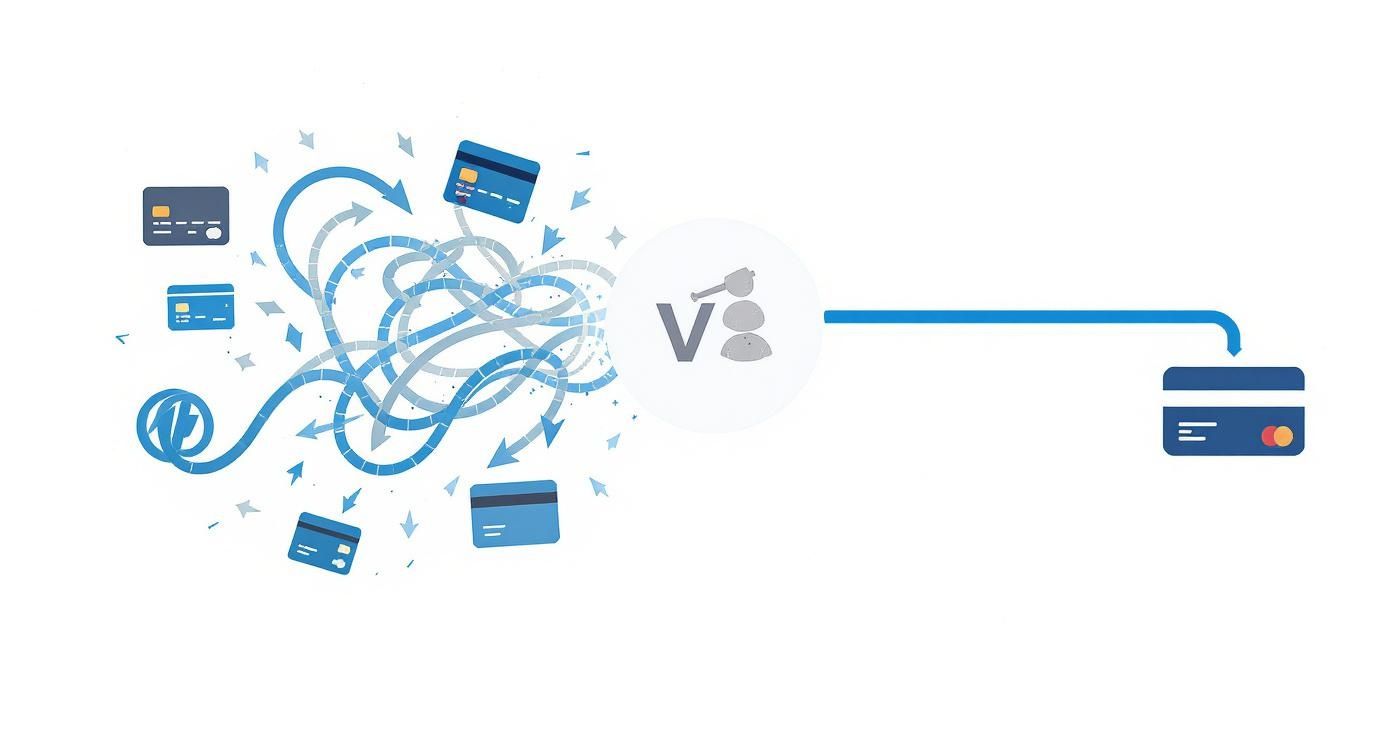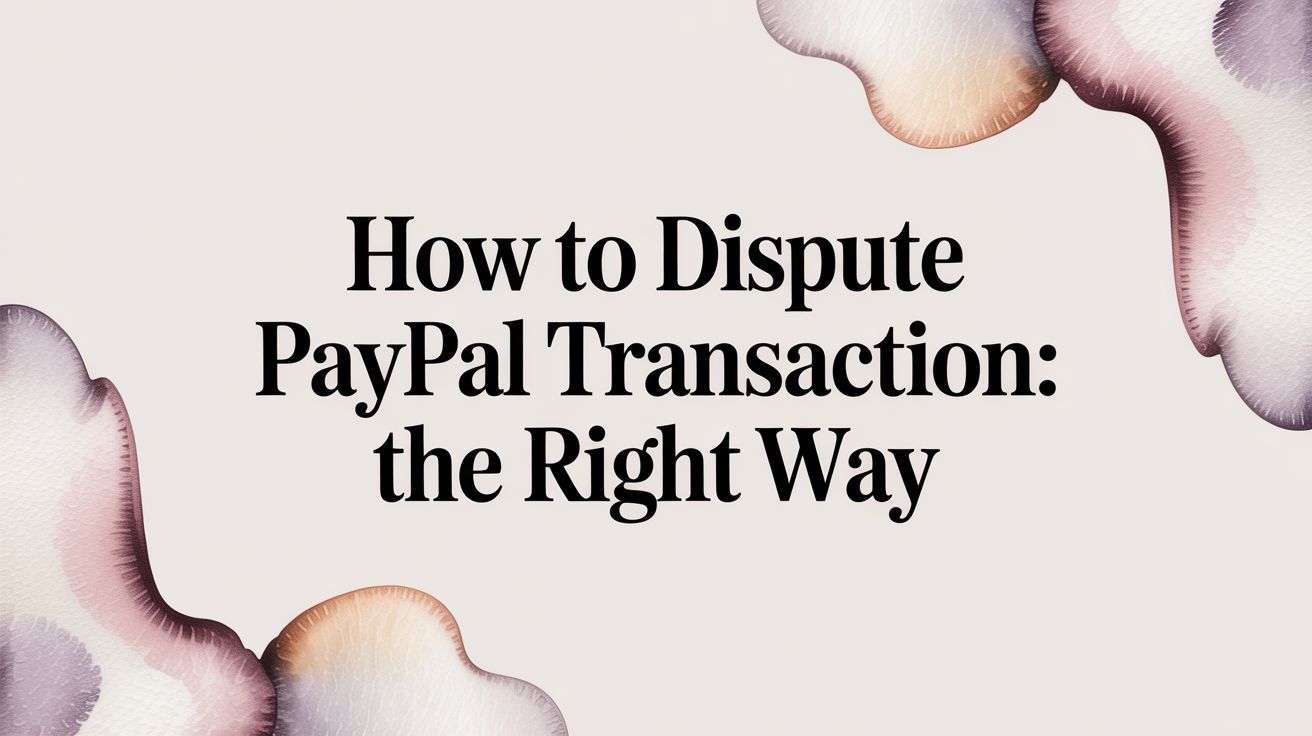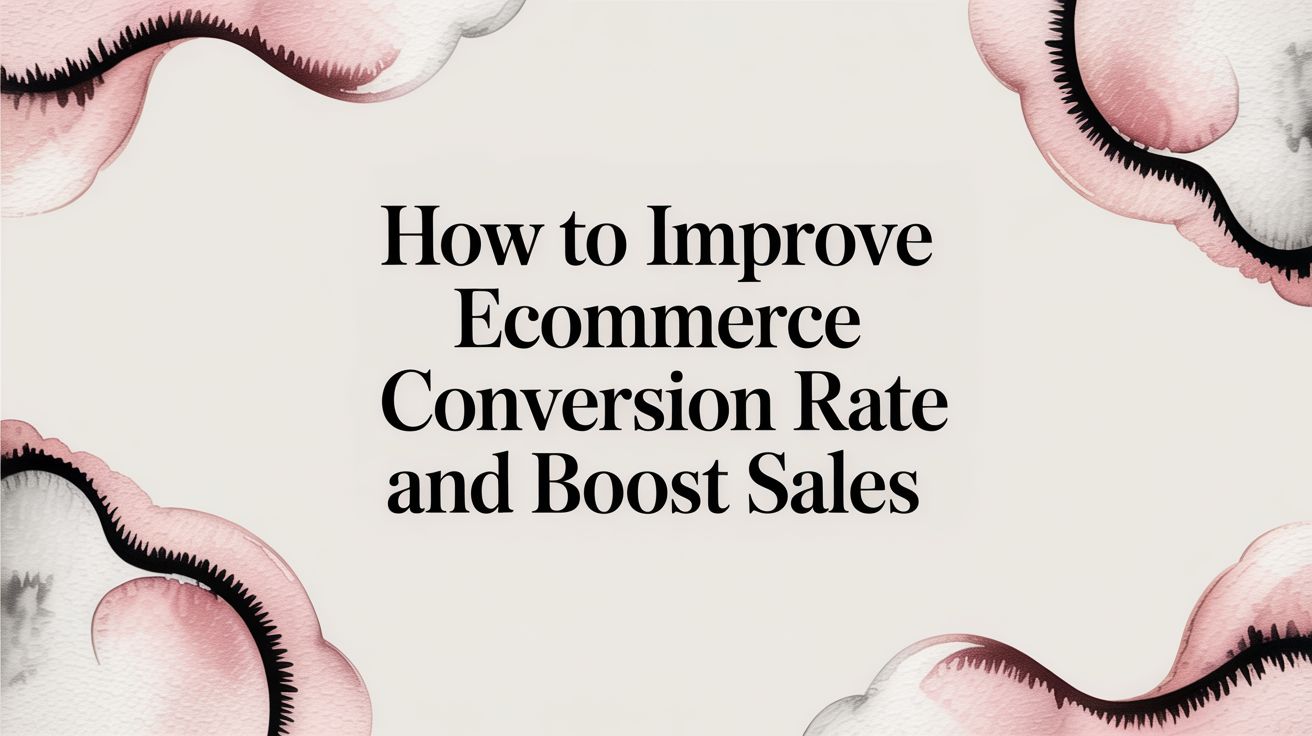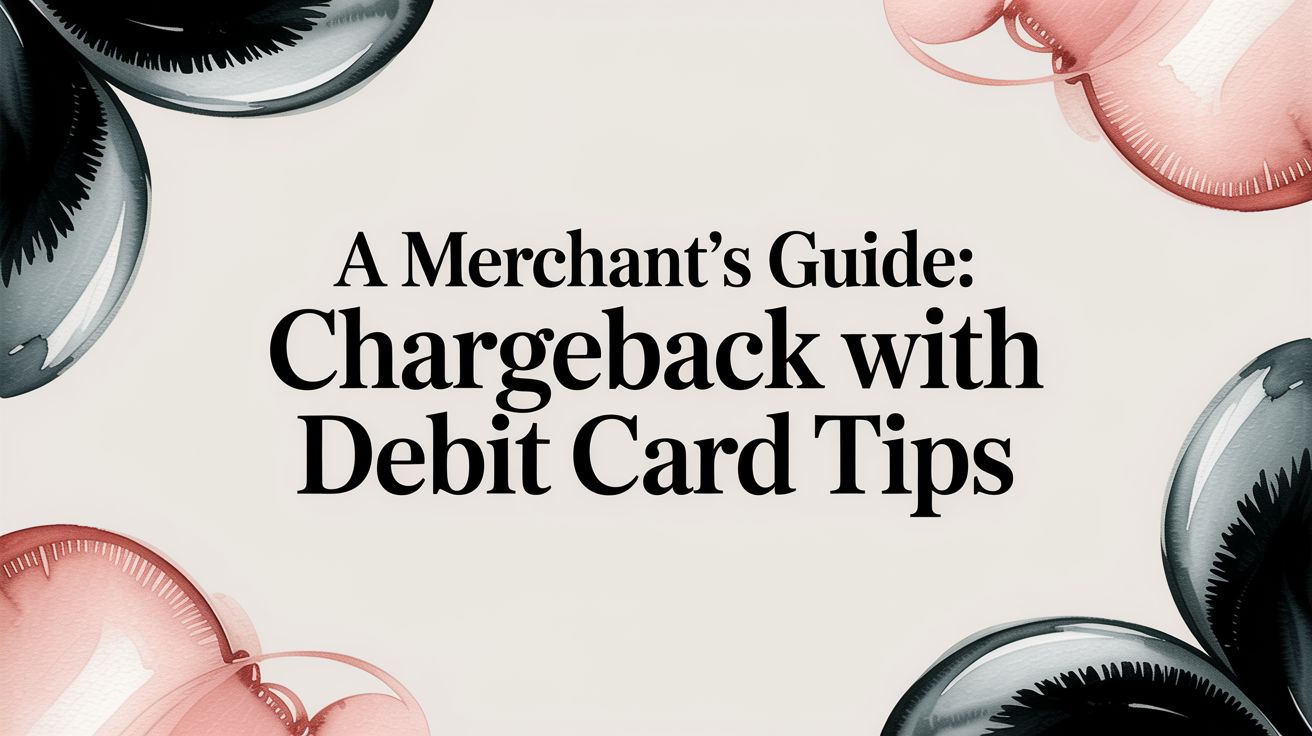
A payment orchestration platform is basically a single layer of technology that connects your business to a whole world of payment gateways, processors, and other services—all through just one integration. Think of it like a universal travel adapter for your entire payment system. It lets you plug into any payment method or provider you need without having to build a custom setup for each one.
Your Guide to Simplifying Global Payments
Trying to manage multiple payment systems on your own can feel like conducting an orchestra where every musician speaks a different language. One system only takes credit cards, another is a pro at digital wallets, and a third is needed just to handle specific regional payment methods in another country. It’s chaotic, inefficient, and worst of all, it leads to lost sales whenever a customer’s favorite payment option isn’t available or a transaction fails for no obvious reason.
This complexity is a massive headache for any business looking to grow. As you expand, you have to connect with different payment providers to accept various currencies, stay on the right side of local regulations, and offer the payment methods your customers actually want to use. Every new connection means more technical work, another dashboard to check, and a whole new set of fees to track.
A payment orchestration platform steps in as the "conductor" for this unruly orchestra. Instead of you having to build and maintain dozens of separate connections, you just integrate with one platform. This central hub then intelligently directs all your transactions.
A payment orchestration platform gives you the power to route payments to the best provider in real time based on factors like cost, currency, or approval rates. This single point of control simplifies everything from checkout to reporting.
Essentially, it brings harmony and order back to your payment operations. For businesses trying to keep up with a global customer base, this isn't just a nice-to-have—it's a critical tool for growth. It empowers you to:
- Improve Conversion Rates: By offering more payment options and automatically retrying failed transactions through different providers, you can seriously boost your payment success rates.
- Reduce Operational Costs: A single integration saves countless hours of developer time and cuts down on the complexity of managing a bunch of different vendor relationships.
- Expand Globally Faster: Adding new payment methods or entering new markets becomes as simple as flipping a switch in the platform, not a major engineering project.
To help you see the practical benefits, here's a quick look at common payment headaches and how an orchestration platform solves them.
At a Glance: How Payment Orchestration Helps Your Business
This simplified approach gives you more control and flexibility without the usual technical baggage.
Understanding how each piece of the payment puzzle fits together is key. To get a better feel for the ecosystem, it helps to learn more about what a payment processor does and how it's different from a gateway. Ultimately, the goal of a payment orchestration platform is to hand you the reins of your entire payment stack without the technical burden.
How a Payment Orchestration Platform Works
At its heart, a payment orchestration platform is an intelligent layer that sits between your business and the tangled web of global payments. Instead of painstakingly connecting to every payment gateway, fraud tool, and processor one by one, you just integrate once with the orchestration platform. That single connection opens up an entire network of payment services.
Think of it as a smart traffic controller for your money. When a customer hits "buy," the platform doesn't just blindly send the transaction down the first available road. It instantly analyzes the payment based on a set of rules you’ve put in place.
This analysis takes everything into account: the customer's location, the currency, the card type, even the transaction amount. Based on that data, the platform's smart routing engine picks the absolute best route for that payment to travel, giving it the highest possible chance of approval.
The Transaction Journey Explained
So, what does that journey actually look like? It’s a lightning-fast process that happens entirely behind the scenes, making sure both you and your customer get a smooth, hiccup-free experience.
Here’s a simple breakdown of what happens in that split second:
- Payment Initiation: A customer enters their payment details on your website or app. That info is securely sent to the payment orchestration platform, not to a single, specific gateway.
- Intelligent Routing: This is where the magic happens. The platform might see a customer in Germany using a Girocard and instantly route the payment to a local German processor. Why? Because that processor probably has lower fees and higher approval rates for that exact payment method.
- Authentication & Security: Before anything else, the transaction can be passed through integrated fraud detection tools for a quick check. All the sensitive card data is also locked down tight. If you want to get into the nitty-gritty of how that data stays safe, you can learn more about tokenization in payments in our detailed guide.
- Transaction Processing: The payment is then sent to the chosen gateway and processor to get the green light. If the transaction fails for some reason—maybe a temporary outage on the provider's end—the platform can automatically retry it through a backup provider without anyone noticing.
- Confirmation & Settlement: Once approved, a confirmation zips back through the platform to your store and the customer. All the data from every transaction, no matter where it was processed, lands in one central dashboard for dead-simple reporting and reconciliation.
This infographic does a great job of showing the difference between a messy, multi-provider setup and a clean, orchestrated one.

The key takeaway here is the shift from total chaos to complete control. It turns a complex web of connections into a single, manageable flow.
A Single Point of Control
Without a payment orchestration platform, trying to manage all these moving parts is a massive technical and operational headache. Every new payment provider needs its own integration project, ongoing maintenance, and a separate reporting system. It gets messy, fast.
By centralizing your payment stack, you get a unified view of every single transaction, regardless of which gateway, processor, or acquirer actually handled it. This makes it far easier to track performance, reconcile your books, and make smart, data-driven decisions.
This structure is what gives you the power to add, remove, or swap out payment partners without having to rewrite a single line of your website's code. This kind of flexibility is crucial for adapting to new market trends, expanding into new countries, or just hunting for better transaction fees.
Ultimately, the platform does all the heavy lifting, so you can get back to focusing on your business.
Core Features That Drive Business Growth
A payment orchestration platform isn't just about plugging different payment services together; it's about making those connections work smarter for your business. The real magic is in its core features, which are built to solve real-world problems—from rescuing lost sales to making sense of complicated financial reports. These tools work together to transform your payment stack from a simple cost center into a powerful engine for growth.
Instead of just passing payments along, these platforms actively manage them. For every single transaction, they ask, "What's the absolute best way to handle this payment right now?" The answer to that question is what helps you boost revenue, slash operational headaches, and expand your business with confidence.

Single API Integration
At the heart of any payment orchestration platform is the single API. Think of it as a "universal adapter" that gets rid of the biggest technical headache for growing businesses: endless, expensive integrations.
Imagine you want to add three new payment gateways and a new fraud detection tool. In the old days, your development team would have to build, test, and maintain four separate connections. With a single API, they just connect to the orchestration platform once. After that, you can flip new services on or off with a few clicks in a dashboard.
This single point of connection means:
- Drastically reduced development time and costs, freeing up your engineers to work on your actual product.
- Future-proof flexibility, letting you add new payment methods like BNPL or regional wallets without kicking off another massive project.
- Simplified maintenance, since you only have one connection to look after, not a dozen.
Intelligent Transaction Routing
This is arguably the most powerful tool in the payment orchestration toolbox. Intelligent routing, sometimes called smart routing, is a dynamic system that sends each transaction to the best possible payment provider in real-time. It’s not about just sending every payment to a default gateway; it’s about picking the best path based on rules you set.
For example, the platform can automatically route payments based on:
- Lowest Cost: Sending a transaction to the provider offering the lowest processing fee for that specific card type or region.
- Highest Approval Rate: Directing a payment to the gateway that has the best track record for similar transactions.
- Customer Location: Using a local acquirer in the customer's country to boost the chance of approval and sidestep cross-border fees.
The real game-changer here is transaction failover. If a payment gets declined by the first provider—maybe due to a temporary outage or a network glitch—the platform can automatically and instantly retry it through a second or even a third provider. The customer never sees a thing, and you save a sale that would have otherwise been lost.
Unified Reporting and Analytics
When you're juggling multiple payment providers, getting a clear picture of your revenue is a huge pain. Your data is fragmented across different dashboards, each with its own reporting style. Trying to piece it all together is a manual, time-sucking nightmare that’s just asking for errors.
A payment orchestration platform fixes this by pulling all transaction data into one central dashboard. This gives you a single source of truth for all your payment activities, no matter which provider processed them. You can easily track key metrics like authorization rates, fees, and settlement times across all your partners in one place.
This unified view is critical for making smart business decisions, simplifying your accounting, and getting an honest, accurate look at your company's financial health. For a deeper dive into how this data can be used, check out our guide on the importance of transaction monitoring solutions for protecting your business.
The growing need for this kind of control is obvious. In 2023 alone, digital payments grew by 19%, with over 317 billion transactions processed globally. To keep up with this volume, more than half of merchants—53%—adopted orchestration platforms to connect multiple gateways, improving their transaction approval rates by over 26%. To see more data on this trend, you can discover more insights about the payment orchestration market.
Real-World Benefits for Your Business
While the technical specs are cool, let's talk about what really matters: how a payment orchestration platform actually helps your bottom line. Forget the diagrams and jargon for a second. We're going to focus on the tangible results that show up in your revenue, costs, and day-to-day operations. This is where the real value kicks in.
By getting your entire payment stack organized and optimized, you aren't just tidying things up. You're actively creating new opportunities for growth. Every single payment you rescue and every dollar you save on fees adds up, contributing directly to a healthier, more scalable business.

Directly Increase Your Revenue
The first thing you'll notice is a real lift in revenue, and it almost always comes from getting more payments to go through successfully. When a customer's payment fails, that sale is usually gone for good. A payment orchestration platform fights this problem in two really powerful ways.
First, smart routing is a game-changer. It sends every transaction to the payment gateway that's most likely to approve it, boosting the odds of success right from the start. But what if it still fails? That’s where the platform’s automatic failover feature comes in, instantly retrying the payment through a backup provider before the customer even knows something went wrong.
This seamless recovery process turns what would have been a lost sale into a completed one. Instead of your customer seeing a frustrating "Payment Declined" error, they get a smooth checkout experience. That means less cart abandonment and higher conversion rates for you.
This kind of proactive payment management is becoming a must-have. The market for these platforms is expected to explode, growing from an estimated USD 1.8 billion in 2025 to a whopping USD 13.4 billion by 2034. This trend makes it pretty clear: businesses that want to capture every possible sale are getting on board. You can dive into the full research on the payment orchestration platform market growth to see where things are headed.
Achieve Significant Cost Savings
It's not just about making more money; it's also about spending less. Orchestration helps trim your expenses in a few key places, but the biggest savings usually come from lower payment processing fees.
Because you can route transactions to the most affordable provider in real-time, you're no longer stuck with one provider's pricing. This simple ability creates some healthy competition for your business, making sure you get the best rate on every single transaction.
On top of that, orchestration delivers some serious operational savings:
- Reduced Developer Costs: Your engineering team integrates just once with the orchestration platform, not dozens of times with individual payment providers. This frees up countless hours of development and maintenance work, letting your team focus on your actual product.
- Lower Chargeback-Related Costs: Getting transactions approved is one thing, but you still have to deal with the disputes that pop up. Integrating smart tools can make this a whole lot easier. To see how, check out our guide on automated chargeback and dispute management.
- Minimized Cross-Border Fees: Selling internationally? The platform can route payments through local acquirers, helping you dodge the hefty fees that often come with cross-border transactions.
Boost Team Efficiency and Market Agility
Finally, a payment orchestration platform gives your business the speed and flexibility it needs to adapt and grow. With everything centralized, your finance team gets one unified view of all transactions. Reconciliation and reporting become drastically simpler. No more logging into ten different dashboards just to piece together your financial data.
This agility is huge when you want to expand. Thinking about selling in a new country? Instead of a months-long project to integrate a new local payment method, you can often just switch it on with a few clicks. This lets you test new markets and respond to what your customers want faster than your peers. In the end, your teams spend less time wrestling with manual payment tasks and more time driving the business forward.
Future-Proof Your Payment Strategy
The world of payments moves fast. What customers want today can feel like old news tomorrow. That's why thinking about payment orchestration isn't just about solving today's problems—it's a strategic move to get your business ready for whatever comes next. It’s about building a payment system that’s as agile and ambitious as your company.
This kind of agility gives you the freedom to adapt without needing a massive engineering overhaul. When the next big payment method—like a new Buy Now, Pay Later (BNPL) service or digital wallet—starts to catch on, you won't be playing catch-up. Instead of a months-long integration project, you can simply switch it on within your orchestration hub.
Staying Ahead of Customer Expectations
A flexible payment stack lets you meet customers where they are. This isn't just about convenience; it’s about building trust and creating a smooth checkout experience that keeps them coming back.
To stay nimble, it's worth understanding how payment solutions are reshaping finance and what that means for your own strategy. The power to quickly add or swap out payment options ensures you’re always ready to serve a global customer base with their favorite ways to pay.
This adaptability is only becoming more important as the market expands. Projections show the global payment orchestration platform market is expected to balloon to an estimated USD 14.98 billion by 2035. This explosive growth underscores just how essential these platforms are becoming for modern commerce. You can dig into these payment orchestration market findings to get the full picture.
Building a Scalable Foundation
At the end of the day, a payment orchestration platform gives you the foundation for sustainable growth. It helps streamline your operations, trims unnecessary costs, and can even lift your revenue by making sure more transactions go through successfully. It also plays a key role in keeping those transactions secure. For more on that, take a look at our guide on what 3-D Secure authentication is and how it fits into the payments puzzle.
By removing the technical roadblocks, you free up your team to focus on what truly matters: improving your products and growing your business. It transforms payments from a complicated operational hurdle into a powerful tool for expansion.
Choosing to implement a payment orchestration platform is a commitment to building a more resilient, customer-friendly business. It makes sure your payment strategy can evolve just as quickly as the market does, keeping you ready for whatever the future holds.
Got Questions? We’ve Got Answers.
Diving into the world of payments can feel a bit overwhelming, and it's natural to have questions. To clear things up, here are some quick, straightforward answers to the things businesses usually ask when they start looking into a payment orchestration platform.
Getting the lingo right is always a good place to start. A lot of people wonder how this new layer of tech is any different from the payment tools they’re already using.
What's the Difference Between a Payment Gateway and an Orchestration Platform?
Think of a payment gateway as a single, dedicated pipe. It creates one connection between your online store and one specific payment processor. It’s absolutely essential, but it’s a simple one-to-one relationship.
A payment orchestration platform, on the other hand, is more like the central control room for all your payment connections. Instead of just one pipe, it connects you to a whole network of them—gateways, processors, fraud tools, you name it. It then intelligently routes every single transaction through the best possible path to boost success rates and cut down on costs. And the best part? You manage all of it through a single integration.
Is Payment Orchestration a Good Fit for Small Businesses?
Yes, absolutely. While it’s easy to see the massive benefits for large, global companies, small and medium-sized businesses can get a major leg up, too. This isn't just a tool for enterprise giants anymore.
For smaller businesses, it opens up a world of possibilities:
- Offer a much wider variety of payment methods to your customers.
- Slash transaction fees by using smart routing to always find the cheapest path.
- Expand into new markets without needing a big, dedicated development team to build out the infrastructure.
Many providers now offer flexible plans and pricing designed to fit the scale and budget of growing businesses.
How Hard Is It to Implement a Payment Orchestration Platform?
This is one of the best parts. A core benefit of a payment orchestration platform is that it actually simplifies your tech stack. Instead of your team building and maintaining a dozen different time-consuming connections for every payment service, they only need to plug into a single API.
While there’s an initial setup, it’s far less complex and resource-heavy than trying to manage a tangled web of separate integrations. This slashes the long-term maintenance burden and frees up your developers to focus on building your business, not just keeping the payment lights on. It's an upfront investment that pays for itself surprisingly fast in saved time and headaches.
Ready to stop losing money to chargebacks? ChargePay uses AI to automate the entire dispute process, helping you recover up to 80% of lost revenue without lifting a finger. See how our hands-free solution can boost your win rates and protect your bottom line at https://www.chargepay.ai.







.svg)







.svg)
.svg)
.svg)